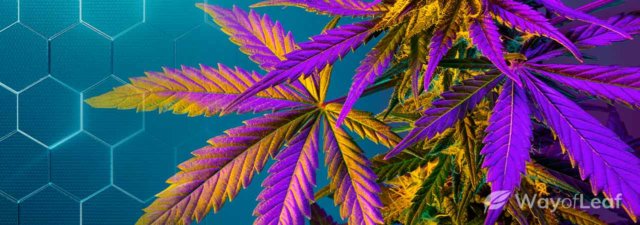CBD is one of the many compounds found in the cannabis plant. Science is just beginning to uncover the medicinal benefits of this cannabinoid, and findings thus far are promising. Over the last few years, cannabidiol has become so popular that it is now being extracted, produced, and manufactured into a wide range of products. These products include edibles, CBD oils, and even creams.
CBD oil is especially popular. It is used to treat a host of illnesses and works by interacting with the endocannabinoid system (ECS) without providing users with a ‘high.’
In this article, we will look at the best ways to extract CBD from the cannabis plant. But first, let’s find out what the substance is and why it is so coveted.
Explaining What CBD Is
If you are reading this article, you likely know what THC is. Delta-9 tetrahydrocannabinol is the most psychoactive ingredient in cannabis, and until recently, was by far the best-known.
THC is renowned for the mind-altering high it induces when consumed. In contrast, CBD is not psychoactive, but it does promote positive changes in the body.
The way CBD affects our body is quite different from THC in the sense that it is not involved in direct stimulation of the CB1 and CB2 receptors. The major impact of CBD is on other receptors such as serotonin, adenosine, and vanilloid.
CBD and Receptors
The stimulation of the TRPV-1 (vanilloid) receptor by CBD influences various processes, including body temperature, inflammation, and pain perception.
Moreover, CBD is known to inhibit the functioning of the FAAH enzyme that directly acts on the CB1 receptor and enables THC to produce its psychoactive effect. CBD has established global interest among industry specialists, and its discovery has prompted medical experts to take a closer look at the benefits.
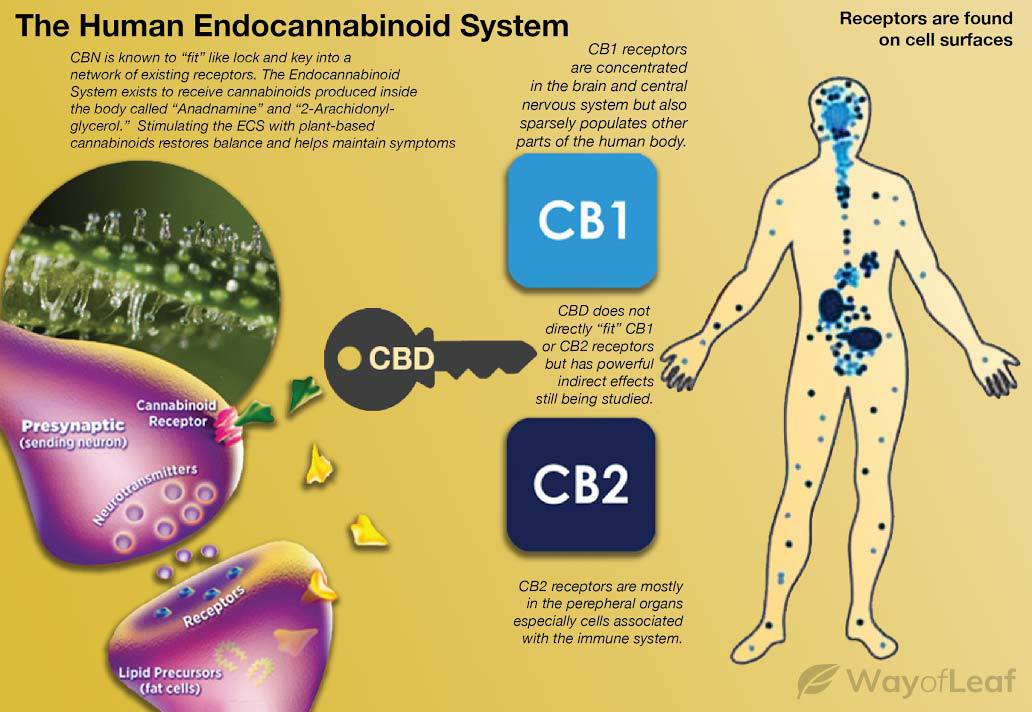
What Are CBD’s Benefits?
While studies are still trying to get to the heart of the matter, it appears as though some of the best CBD oils and other CBD products could have a plethora of medical benefits.
Anti-Inflammatory Properties
As a society, we are developing an over-reliance on pain medication to deal with issues, such as inflammation. According to a study in the Journal of Experimental Medicine, CBD reduced the levels of chronic inflammation in rats and mice. CBD has also been known to help with chronic pain conditions such as fibromyalgia and multiple sclerosis.
Mental Health Disorders
A study published in Current Pharmaceutical Design suggested that CBD had a similar effect to certain antipsychotic drugs. Further studies showed that CBD could have a positive impact when used on people with neurological disorders. It also has potential anti-seizure properties and is used by individuals with epilepsy.
The above is just a taste of what CBD can do to help with certain medical ailments. Let’s take a look now at how it is extracted from the cannabis plant.
CBD Extraction Methods
The purpose of CBD extraction is quite simple; to end up with the cannabinoid (and others) in a highly concentrated form to make it suitable for human consumption.
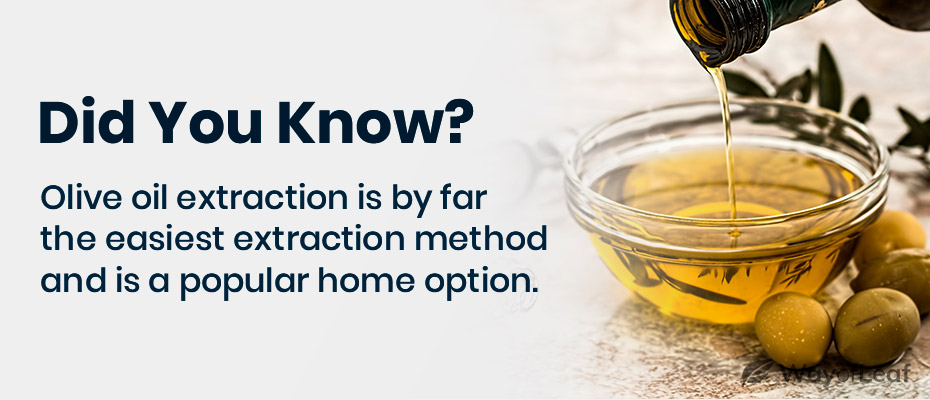
To achieve this, you must use a plant material rich in CBD, such as special cannabis strains or hemp. Certain cannabis strains such as AC/DC and Charlotte’s Web have a high CBD concentration (up to 18% in some cases) and a low THC concentration (as little as 5%). You need a favorable CBD/THC ratio because even in cases where plants have a THC concentration of up to 6%, the extra high CBD content should hopefully render the psychoactive effects of THC inert.
Industrial Strains and Extraction
Various strains of industrial hemp can also be used to extract CBD. They are grown around the world legally, including in India, China, and several countries in Western Europe. One of the most popular industrial hemp strains is Fedora 17. It has a low THC content which means any CBD extracted from it should have no psychoactive effects.
CBD oil made from hemp is legal in many countries around the world, including in all 50 states in the U.S., because of the negligible THC content.
Without further ado, let’s look at the 4 most common CBD oil extraction methods.
1 – The CO2 Cannabis Extraction Method
This form of CBD extraction is actually divided into supercritical, subcritical, and ‘mid-critical’ categories. But supercritical is by far the most commonly used. In fact, it is the most regularly used extraction method of all because it is safe and provides a pure end product.
In simple terms, CO2 cannabis extraction uses pressurized carbon dioxide (CO2) to pull CBD (and other phytochemicals) from the plant. CO2 acts like a solvent at certain temperatures but possesses none of the dangers. While it is safe and effective, it also involves expensive equipment which freezes the CO2 gas and compresses it into a supercritical cold liquid state.
CO2 & Extraction
CO2 typically behaves like a gas at standard pressure and temperature. And it is easily changed to a solid while in this state. The solid version of the gas is known as dry ice. Using the aforementioned equipment in a lab, you can turn CO2 gas into a liquid by ensuring the temperature drops below -69 degrees Fahrenheit while increasing the pressure to over 75 pounds per square inch (psi). At this stage, you have your starting point for CO2 cannabis extraction. Next, you will follow one of the three steps described below.
Supercritical Extraction
Once you have the liquid CO2, the next step is to increase the temperature and pressure past the point where the liquid becomes ‘supercritical.’ This term means the CO2 can now adopt properties halfway between a gas and liquid simultaneously. Effectively, the supercritical CO2 can fill a container (like gas) while also maintaining density (like a liquid). When CO2 is in its supercritical state, it is ideal for chemical extraction. This is because it won’t cause denaturation or any damage that would make the CBD unfit for human consumption.
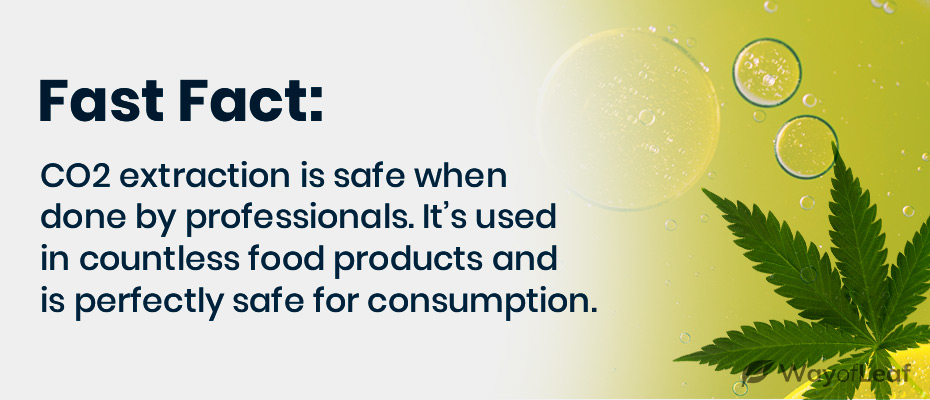
Liquid CO2
To extract the CBD oil using this technique, you simply begin with liquid CO2 and raise its pressure via a compressor. The temperature must also be raised, which can be done using a heater. The next step involves passing the supercritical carbon dioxide through some high-quality cannabis. This is how the CO2 will pull the essential trichomes (the sugary-looking coating of the cannabis plant) and terpene oils (essential oils) out of the plant.
The solution gets passed via a separator and is broken down into its requisite parts. The good stuff (including trichomes and terpenes) is sent to the collection container. Meanwhile, the supercritical CO2 goes through a condenser and is turned back into a liquid. Finally, the liquid goes to a special storage tank and can be used to begin the process all over again.
WAYOFLEAF’S CHOICE – FabCBD
When it comes to selecting the best and most effective CBD, it really comes down to trial and error and testing out as many products as you can. And that’s exactly what we did. Our review team tried and tested dozens of CBD brands, and we rated FabCBD as #1 overall for potency, value for money, quality & reputation. Try them today and you won’t be disappointed. You can also view the reviews of the best CBD brands here.
Subcritical extraction
This form of extraction involves low temperatures and low pressure. Subcritical extractions take longer than their supercritical counterparts and also produce a smaller yield. While it retains the terpenes, essential oils, and other sensitive materials, it doesn’t extract larger molecules such as chlorophyll and omega 3 and 6. The benefit of subcritical extraction, however, is that it is less likely to damage terpenes.
Mid-critical is simply a general range between subcritical and supercritical. Some companies combine supercritical and subcritical to create a full-spectrum CO2 cannabis extract. They use the subcritical extraction method to separate the drawn-out oil and the very same plant material using supercritical pressure. The oils are then homogenized into one, which creates an amalgamated oil. This is known as the CO2 Total Extraction Process.
Pros and Cons of CO2 Cannabis Extraction
| CO2 Comparison | 1 | 2 | 3 |
|---|---|---|---|
| Pros | Safety: CO2 is a common food additive and is used to produce things like carbonated soft drinks. | Effectiveness: CO2 has been used as an extraction solvent for years by food companies. It is used to remove caffeine from coffee and as an extraction solvent when producing essential oils. | Purity: The cannabinoids produced are potent and free of chlorophyll with minimal risk of contaminants. |
| Cons | Expensive: You can only complete the process with the aid of extremely expensive equipment. | Technical Ability: CO2 Cannabis extraction is not something that should be attempted by an amateur chemist. |
2 – The Olive Oil Extraction Method
The first step in olive oil extraction, which can be performed at home, involves ensuring the raw plant material is decarboxylated. In layman’s terms, it means you have to heat the plant to a certain temperature for a specific length of time to activate the plant’s chemicals.
Most experts recommend heating at 248 degrees Fahrenheit for 60 minutes or 284 degrees Fahrenheit for 30 minutes. Once this step is completed, plant material is added to the olive oil and heated to 212 degrees Fahrenheit for up to 2 hours (and at least 1 hour). This process should result in the extraction of cannabinoids.
Pros and Cons of the Olive Oil Extraction Method
| Olive Oil Comparison | 1 | 2 |
|---|---|---|
| Pros | Very Safe: This method has been deemed safe and effective | Inexpensive: You can set everything up at home without breaking the bank. |
| Cons | Perishable: Regardless of whether your cannabis-infused oil is high in CBD or THC, it is highly perishable so you must store it in a cool, dark place and use as soon as possible. | Low Yields: This form of extraction only produces fairly low yields. |
3 – The Dry Ice Extraction Method
The dry ice extraction method is another way to extract CBD, and it can be performed at home. Although, it takes a bit more time and effort than its olive oil equivalent. As well as the cannabis plant itself, you’ll need the following equipment:
- Around 3 pounds of dry ice
- A large piece of Plexiglas or a mirror
- A paint scraper or putty knife
- Thick gloves that are heat resistant and eye protection
- A clean 5-gallon plastic bucket
- 3 bubble hash mesh bags; sizes are 73, 160, and 220 microns
- 3 large, clean glass jars for storage
Steps:
Put on your gloves and eye protection, chop up the cannabis buds into small pieces and place it in the bucket. Cover the plant with the dry ice and leave it for 3 minutes. It is best only to fill the bucket halfway. This process causes the freezing of the trichome resins. Fit the 73-micron bag over the bucket and shake the ice & plant combo for about 4 minutes; this knocks the frozen trichomes off.
Turn the bucket upside down on the Plexiglas and shake as much resin through the mesh bag as possible. Scrap the hash off the Plexiglas with your scraper and place it into one of the jars. Repeat with the 160 and 220-micron mesh bags, and you’ll be rewarded with three different strains of extract.
Pros and Cons of the Dry Ice Extraction Method
| Dry Ice Comparison | 1 | 2 | 3 |
|---|---|---|---|
| Pros | Ease of Use: The steps above are very easy to follow. | Clean: Unlike other methods, there is very little mess with dry ice extraction. | Decent Yield: You’ll end up with a lot more than if you use oil extraction. |
| Cons | Low-Quality: This is entirely dependent on the user, but you will ruin the quality of the product if you shake it for too long. | Not Always Easy Getting Dry Ice: Depending on where you live, it isn’t always so easy to get your hands on 3 pounds of dry ice unless you order it online. |
4 – The Solvent Extraction Method
Ethanol, low-grade alcohol, and butane are among the most common substances used in solvent extraction. Although ethanol extracts the full range of cannabinoids and terpenes from the plant, it also extracts chlorophyll, leading to some unpleasant side effects.
You can remove the chlorophyll by filtering the extract, but you significantly reduce the oil’s potency. Butane offers a stronger oil than ethanol, but it is more likely to contain solvents that could irritate the lungs.
For extraction, the liquid is added to the plant material. The extraction liquid will strip away the cannabinoids and flavor from the plant material but will probably take some green colorings too. Once enough cannabinoids have been extracted, heat the liquid to evaporate it down to the CBD base oil.
Pros and Cons of the Solvent Extraction Method
| Solvent Comparison | 1 | 2 |
|---|---|---|
| Pros | Appropriate For Some Products: If you use high-grade alcohol, you may produce good quality oil. | Straightforward Process: Once you have the equipment, it isn’t difficult to complete. |
| Cons | Extremely Dangerous: Butane and Ethanol are flammable, so it isn’t worth starting a fire in your home to extract CBD in this manner. | Potentially Harmful: As well as destroying plant waxes, this form of extraction may produce oil that contains chlorophyll or other harmful contaminants. |
Final Words About CBD Extraction
It is essential to understand the various CBD extraction methods as they significantly impact the quality of the end product, not to mention your health. We don’t recommend utilizing the solvent method because it is dangerous to make and is also more likely to cause health problems. The cost of CO2 supercritical extraction means it is not possible for 99.9% of readers, but it is an excellent, safe, and efficient method.

Those who create their own CBD oils will tend to use dry ice or olive oil, which provide great purity and are easy to do. There are also other extraction methods that we have not mentioned in this guide. If you have experience extracting CBD from the cannabis plant and would like to share your method, please contact us in the comments or through our Facebook page.
For those that are looking for high-quality CBD products from brands you can trust, feel free to view the list of top-rated brands below.


![How Is Delta 8 Made? [A Full Explanation]](https://wayofleaf.com/wp-content/uploads/2021/06/wol-banner-how-is-delta-8-made-640x225.jpg)

![What Is Geraniol? [Cannabis Terpene Guide]](https://wayofleaf.com/wp-content/uploads/2020/10/wol_what-is-geraniol-640x225.jpg)

![Do Terpenes Get You High? [Understand the Facts!]](https://wayofleaf.com/wp-content/uploads/2019/08/mj_do_terpenes_get_you_high_1920-min-640x225.jpg)
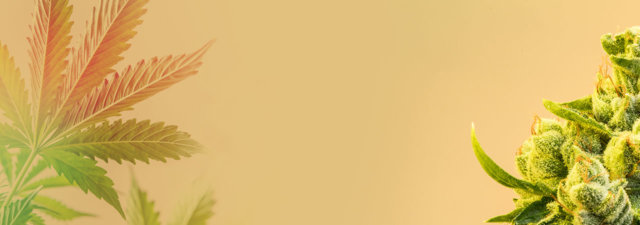

![Medical Cannabis Vs. Morphine [The Difference]](https://wayofleaf.com/wp-content/uploads/2018/11/mj_medical-cannabis-versus-morphine-640x225.jpg)
![How Much THC is in a Dab, Bowl, and a Joint? [Explained]](https://wayofleaf.com/wp-content/uploads/2019/03/wol_1920x450-39-640x225.jpg)
